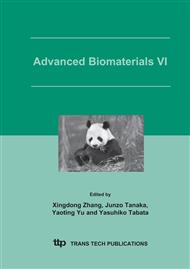p.591
p.595
p.599
p.603
p.607
p.611
p.615
p.619
p.625
Fretting Damage of Human Cortical Bone in Transverse Orientation against Titanium
Abstract:
Under simulated human physiological solution, the fretting behaviors of flat cortical bone specimen from fresh human femur in the transverse orientation were investigated by sliding against pure titanium ball counterpart (tangential fretting technique). The friction coefficients and logs were calculated automatically. The worn surfaces of the cortical bone were analyzed by means of laser confocal scanning microscopy. The results show that the fricion coefficient of cortical bone directly relate with the magnitudes of displacement. The friction logs for cortical bone change with the magnitudes of displacement (Fn=90N) from elastic partial slip (D≤5 µm), plastoelastic partial slip (D=10 µm) to slip (D ≥20 µm) respectively. The fretting damages of cortical bone in the elastic partial slip were slight. But ploughs and delaminations were observed in the plastoelastic partial slip and gross sliding with loss of contact stiffness of cortical bone. The wear depth increased with cycles and well related to the friction coefficient of cortical bone in each fretting regime. Controlling the displacement amplitude and friction coefficients of bone-implant interface, it might be helpful to increase the anti-fretting capacities of human cortical bone.
Info:
Periodical:
Pages:
607-610
Citation:
Online since:
June 2005
Authors:
Keywords:
Price:
Сopyright:
© 2005 Trans Tech Publications Ltd. All Rights Reserved
Share:
Citation:


